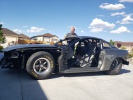so the idea is to push the END of injection back further towards the intake so there isnt a pile of fuel sitting behind the intake valve waiting to get sucked straight through the open exhaust valve upon opening into the overlap event.
where this happens.....the motor will tell you its efficient spot based on peak mid range torque output and when the wideband shows proof of limited gain. if you record stock values and then push the event back and increase burn efficiency then the motor will need less fuel to run the new event. naturally your wideband would show a rich state that you would then need to correct by leaning out the mixture. if you keep testing this and see limited gains then you found the beginning off the efficiency window. the dyno is your real tell all as to where the sweet spot is. for most the smell factor and the wideband will get you close enough.
the math is fairly simple here. The computer measures incoming density and uses the tables to come up with a desired injector on time in ms we can call IMS. The boundary tells the computer you have this much time to get it done, and the normal says within the boundary window i want you to quite spraying at here...END.
Boundary and Normal define -END
END+IMS= start of injection. If the window isnt big enough you dont get full spray. anything else falls withing the limit. the EOI is a coded known (that user defines) based on revolution. the injector ms is added to this to determine a start of injection (SOI). By shifting EOIT you effectively move SOIT because SOIT is calc'd from EOIT.
RPM / 60,000 = Rev per ms. from here you can define the amount of angular rotation in one ms and thus convert IMS (R/ms) to angular rotation in deg/ms to determine required spray time.
some aftermarket computers can let the user decide if they want to reference spray off of EOI or SOI. most tuners i ran into used EOI because the users started off with some sort of GM knowledge and were comfortable with EOI already. either way the job still gets done.






 Reply With Quote
Reply With Quote